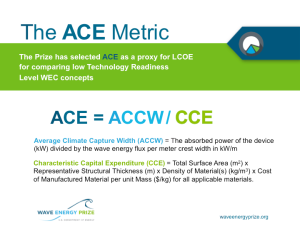The Hydrodynamic Performance Quality (HPQ) of a Wave Energy Converter (WEC) Technology
By Diana Bull, Sandia National Laboratories
The two components that comprise the Average Climate Capture Width per Characteristic Capital Expenditure (ACE) metric are the most important levelized cost of energy (LCOE) drivers for WEC devices, however there are many other influential parameters. Although a scaled wave tank test cannot provide information on all influential parameters (system availability, installation, etc.), it can provide substantial useful information beyond ACE.
ACE requires knowledge of the power absorbed by the device in a West Coast deployment climate and the Characteristic Capital Expenditure needed to build the device. By requiring additional sensors to monitor other aspects of the devices performance, processing the data to obtain alternative views beyond averages, and subjecting the devices to additional wave environments, much more can be learned about a device’s overall performance. In addition to monitoring averaged absorbed power, the devices will be outfitted with sensors that measure mooring forces, accelerations, and the position of the device. This data will be processed to reveal statistically significant peak values, ratios between peaks and means, as well as identifying events like end-stop impacts. Lastly, all of the sensors and processing will occur not only for the irregular wave spectra used to establish average climate capture width (ACCW), but also for two large irregular wave spectra (LIWS) and two realistic wind swell spectra (RWS).
This additional data will be processed into six performance-related quantities for each device tested in the MASK basin. These performance-related quantities are:
- Statistical peak of mooring watch circle (WCHPQ)
- Statistical peak of mooring forces (MFHPQ)
- Statistical peak-to-average ratio of absorbed power (APP2A,HPQ)
- End-stop impact events (ESHPQ)
- Absorbed power in realistic seas (RSHPQ)
- Adaptive control effort (ACHPQ)
These quantities relate to aspects of the techno-economic performance not addressed by ACE and will allow devices to distinguish themselves on more levels then the ACE metric alone provides.
Each of these hydrodynamic performance-related quantities will be allocated to a factor (in the range of 0.94 – 1.06) and the HPQ of a device will be established by multiplying the ACE metric by the factors allocated to each performance-related quantity.
HPQ = ACE * ( MFHPQ * WCHPQ * APP2A,HPQ * ESHPQ * RSHPQ * ACHPQ )
Each of these factors may have limited beneficial, non-beneficial or no influence on the HPQ. The allocation of the factors from the performance-related quantities will be the responsibility of the judging panel.
The HPQ will establish that the winners’ designs will more effectively address key aspects of the techno-economic performance. The HPQ continues to encourage teams towards a systems-level engagement through the end of the competition. At the end, the device with the highest HPQ that has surpassed the ACE threshold will be declared the winner of the Wave Energy Prize.
